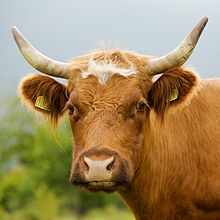Our website is made possible by displaying online advertisements to our visitors.
Please consider supporting us by disabling your ad blocker.
Natural reservoir

In infectious disease ecology and epidemiology, a natural reservoir, also known as a disease reservoir or a reservoir of infection, is the population of organisms or the specific environment in which an infectious pathogen naturally lives and reproduces, or upon which the pathogen primarily depends for its survival. A reservoir is usually a living host of a certain species, such as an animal or a plant, inside of which a pathogen survives, often (though not always) without causing disease for the reservoir itself. By some definitions a reservoir may also be an environment external to an organism, such as a volume of contaminated air or water.[1][2]
Because of the enormous variety of infectious microorganisms capable of causing disease, precise definitions for what constitutes a natural reservoir are numerous, various, and often conflicting. The reservoir concept applies only for pathogens capable of infecting more than one host population and only with respect to a defined target population – the population of organisms in which the pathogen causes disease. The reservoir is any population of organisms (or any environment) which harbors the pathogen and transmits it to the target population. Reservoirs may comprise one or more different species, may be the same or a different species as the target, and, in the broadest sense, may include vector species,[2] which are otherwise distinct from natural reservoirs. Significantly, species considered reservoirs for a given pathogen may not experience symptoms of disease when infected by the pathogen.
Identifying the natural reservoirs of infectious pathogens has proven useful in treating and preventing large outbreaks of disease in humans and domestic animals, especially those diseases for which no vaccine exists. In principle, zoonotic diseases can be controlled by isolating or destroying the pathogen's reservoirs of infection. The mass culling of animals confirmed or suspected as reservoirs for human pathogens, such as birds that harbor avian influenza, has been effective at containing possible epidemics in many parts of the world; for other pathogens, such as the ebolaviruses, the identity of the presumed natural reservoir remains obscure.
- ^ "Principles of Epidemiology | Lesson 1 - Section 10". CDC. 2012. Retrieved 2017-11-10.
- ^ a b Haydon, D. T.; Cleaveland, S.; Taylor, L. H.; Laurenson, M. K. (December 2002). "Identifying Reservoirs of Infection: A Conceptual and Practical Challenge". Emerging Infectious Diseases. 8 (12): 1468–1473. doi:10.3201/eid0812.010317. PMC 2738515. PMID 12498665.
Previous Page Next Page


